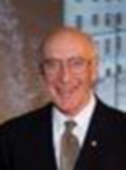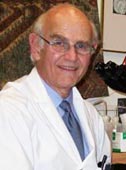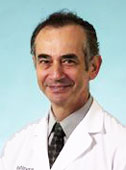The Surgeon Scientist Program at 25 Years
The 25th anniversary of the Surgeon Scientist Program
was celebrated with a gala dinner and a day of spectacular
scientific presentations. There were many colorful
reminiscences. I have tried to capture some of them
in this incomplete account of a great program in academic
surgery. Charles Tator divided the history of the
Department into two eras "B.B and A.B." for events
occurring before and after Bernie Langer's tenure as
Chair. I will follow his taxonomy.
In the "B.B." era the highly respected clinical training
program in the University of Toronto's Department
of Surgery lacked an organized pathway for training
academic surgeons. There were a few excellent research
laboratories in the department, but there were still many
residents assigned to research whose experience was
sub-optimal. Some were required to do research as the
price of admission to clinical training, even if they had
no real interest. Most did only 1 year in research, some
spending it in the hospital medical records department
doing chart reviews.
After completion of clinical training in Toronto, Bernie
Langer went to the United States for 6 months to study
surgical oncology, followed by six months in Francis
Moore's laboratory at the Peter Bent Brigham Hospital
for basic research training in surgical physiology. Moore
was more interested at that time in pioneering liver
transplantation. This was the beginning of Bernie's
career interest in liver surgery. He also got a clear idea
of how a well developed surgical research program operated
and how it might be integrated with academic
clinical practice.

Bernard Langer
|
After joining the general surgery
staff at TGH, Bernie worked
with Bruce Tovee to put more
emphasis on research training
for new general surgery
recruits. Because of the shortage
of research laboratories in
Toronto they sent surgeons to
various places around the world
to develop their research skills
prior to joining the general surgery
division. Wayne Johnston went to the U.K. to
study vascular disease; Zane Cohen to London to study
colorectal surgery at St. Mark's Hospital; Rudy Falk to
the Karolinska Institute to learn immunology and transplantation;
Bob Stone to New Jersey to study hepatic
physiology. Paul Walker studied muscle physiology at
the Karolinska in Sweden and vascular surgery at New
York University.
At the time Bernie became chair in 1982, there were
a few excellent research laboratories in the department
that provided good training but there were still many
residents assigned to research whose experience was
suboptimal. There was little general oversight of the
quality of either the trainees or the supervisors across
the department. To increase the research productivity
of the department, Bernie set out to strengthen
the research training base in Toronto by selecting out
those residents with an interest in research and providing
them with a structured program of sufficient
length to prepare them for an academic career. He was
influenced in this by his own poor experience in the
research lab and by others like Alan Hudson who had
already established an academic training model in neurosurgery,
sending residents like Jim Rutka to research
centers elsewhere at the end of clinical training for 2
or 3 years.
|
Charles Tator sought formal research training on
his own, earning a PhD in neuroanatomy. Appointed
initially to the clinical service at Sunnybrook, Charles
commuted to a laboratory at the University of
Toronto two days a week for two years.
|

Charles Tator
|
Bernie appointed Steven
Strasberg as chair of the
departmental research committee
and asked him, with
the help of Charles Tator,
Rudy Falk, Nancy McKee
and Bryce Taylor, then director
of postgraduate education,
to design a model for
a separate academic training
stream for surgeons. The
concept was supported by the
senior executive committee of
the department, and the first trainee was Steve Gallinger.
The "A.B." era was getting under way.
Funding was guaranteed by the department for the duration
of training of the Surgeon Scientists. They were
required to spend a minimum of two years, register for a
degree in the Institute of Medical Science and complete
the required courses to meet the standards of the School
of Graduate Studies. A further requirement was that the
supervisor have an appointment in the School of Graduate
Studies. This raised the voltage of scientific competence in
the Department and created a farm system for training academic
surgeons for the department. Bernie: "We wanted
people from great centers to come to Toronto to train
in academic surgery in the way that many were already
coming for clinical training, while Toronto trainees went
elsewhere for their scientific training."
|
General Surgery adopted the program first, followed later
by the other divisions. Funding was a major issue from
the beginning. There were some research fellowships available
from granting agencies and these selected residents
were very competitive, but more was needed. The recently
initiated departmental practiceplan provided Academic
Enrichment Funds that divisions were able to use to support
their own SSP trainees. The University of Toronto
Surgical Alumni Association was also created at that time
to facilitate fundraising from both staff and alumni, primarily
to support the SSP. It was initially led by former surgery
chairman Donald Wilson. Additional contributions
from Johnson & Johnson, private donors, hospitals and
the Faculty of Medicine allowed the program to accommodate
increasing numbers of applicants over the years.
The program was given high visibility and was promoted
in the department. It grew steadily and became a model for
clinician investigator training programs at the University of
Toronto. The surgical residents had the highest completion
rate among graduate students (85%) of any department
in the University. Many of them went on to receive PhDs.
Steven Strasberg adds illuminating background to the
story of the origins of the SSP. "The Institute for Medical
Science was instrumental in the success of the Surgeon
Scientist Program. The IMS was started by Jack Laidlaw,
Earnest (Bunnie) McCollough with Lou Siminovitch as a
strong supporter. It was designed to train clinical scientists.
It gave [graduate school supervisory] privileges to clinicians
without having them cross appointed in a basic science
department. This was critical since it allowed clinicians to
design research training programs suitable for clinicians.
|
Because it was part of the graduate school, SSP trainees
had all the protections afforded to a graduate
student to assure that their training was of high quality.
There were strict criteria for graduation- papers,
theses, excellent oversight in the form of thesis committees,
and regular reviews.
Steven Strasberg
|
Importantly, every individual applying to be a member
of IMS and supervise students had to fulfill criteria of
success in science before becoming a supervisor.

Steven Strasberg
|
While I was on IMS council two important things
happened. First, Dr. McCollough perceived a gap in
the training of medical students
- they weren't learning
the scientific method.
He thought up the concept
of the Undergraduate
Program in Medical Sciences
(UPMS). The important
thing about UPMS is that
it was a program of IMS.
[This led eventually to the
MD/PhD. Program. Ed.]
Secondly, there were a few
surgeons who enrolled students in the MSc program of the IMS, but all were done as
one year efforts. In order to do an MSc in one year a lot of
the thinking had to be done by the supervisor. It was hard
to teach the student think like a scientist. I had already
personally decided not to take any more one year students.
It was just at that time that Bernie appointed me to head
the research committee - he had just become chairman.
He was supportive, but as it was a radical idea to train
residents in science for a minimum of 2 years in the
middle of the residency, he insisted that it go through
the research committee and be approved enthusiastically.
Many of the members of the committee became
involved with the IMS and the SSP was recommended
to the chairman with enthusiasm. Steve Gallinger was
the first [graduate of the SSP]. There are many people
to be thanked for the SSP but I want to get back to
Jack Laidlaw and Bunnie McCollough. They were very
different, but shared qualities of great intelligence, great
vision and magnetism. They did everything for students.
They carved the path - they held the light up for others
to see the path. I can't ever think about them, and I do
so frequently, without feeling the deepest appreciation."
When Nephrologist Mel Silverman became head of
the IMS, he welcomed surgeons into the program and
fostered the success of the SSP. Significantly, he was succeeded
as Director of IMS by the exemplary academic
surgeon, Ori Rotstein. The SSP program grew and
was improved over the years by SSP directors Steven
Strasberg, Richard Wiesel, Ori Rotstein and Ben Alman.
When Bernie was on the Council of The Royal College of
Physicians and Surgeons of Canada, he was involved
in designing and charged with the implementation of
a proposed Clinician Investigator Program based on
the model of the Surgeon Scientist Program. The CIP
now has the status of a new specialty within the Royal
College. This model has been adopted by all the medical
schools in Canada. The current director of the Clinician
Investigator Program in Toronto is the able paediatric
nephrologist Norm Rosenblum.
In the beginning, the fields of study for SSP trainees
were basic biomedical research, surgical education and
clinical epidemiology. The addition of health policy,
management, bioengineering, nanotechnology and bioethics
has expanded the spectrum of surgical scholarship
in the SSP to a level unrivalled in the world.
Donations from the alumni, faculty and friends of the
Department of Surgery are essential to the continuation
of the SSP. Donors can contact Artur Cane in the Office
of Advancement to contribute (phone no. 416-946-
0019, e-mail artur.cane@utoronto.ca).
M.M. with notes from Alan Hudson, Bernie Langer, Steven
Strasberg and Charles Tator
|